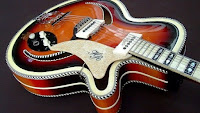Zemaitis guitars are perhaps the worlds most original, stunning and beautiful electric guitars.
British luthier Tony Zemaitis, (Antanus Casimere Zemaitis) was originally from Lithuania. As a boy, Zematiis was obsessed with creating things, such as handmade bicycles, cabinets, and model airplanes. He also learned to play guitar.
By the 1950’s, the 20 year old Zemaitis was building his own guitars. By the early 1960’s he was building guitars for some of the well-known British players. These musicians influenced The Beatles and The Rolling Stones.
He sold these acoustic instruments to friends and only was able to make a few guitars each year.
Zemaitis experimented with his instruments to determine acceptable string scale and differing soundhole shapes.
By 1965, he devoted his career to luthery and began building guitars.
We all know that single coil guitar pickups have a propensity to capture 60-cycle hum from other electric devices, including amplifiers.
In an effort to solve this problem, Tony Zemaitis placed a metal cap on the tops of some of his electric guitars. This was successful solution for shielding out the undesired noise. As a plus, it looked great. Zemaitis did not stop there. He recalled the beautiful engraving designs on high-end firearms such as Western pistols, rifles, and shotguns.
Tony then hired engraver Danny O’Brien to engrave decorations on the metal-topped Zemaitis instruments. These guitars went from musical instruments to works of art.
Zemaitis’ basic design looked somewhat like a Gibson Les Paul Special, with its Florentine cut-away. However, his guitars were much narrower than the Gibson.
Early models had single-coil pickups. Humbucking pickups are what are typically seen on a Zemaitis. His other design has two cutaways.
The lower one is similar to the Les Paul Special design and the upper is a rounded extension, and the bottom cutaway was Florentine.
The metal-topped guitars came in two versions. On the fancy version, the top covered most of the top of the body.
Zemaitis also produced a disc-front version in which a round metal disc covered the area housing the pickups and bridge.
Zemaitis next came up with the beautifully adorned Pearl Top guitar. The top of this guitar featured a mosaic of pearloid tiles and in some cases abalone surrounding the pearl, causing a sparling illusion of colour change under stage lights.
Despite the fancy top, the rosewood fretboard on most Zemaitis guitars is rather plain, bearing only dot markers. Some models have bound necks and others have plain necks.
By the 1980’s Zemaitis’ fame was widespread. His guitars were very expensive. They were hand built and handcrafted.
Many popular artists such as Ron Wood, Eric Clapton, and George Harrison owned and played Zemaitis guitars. The bodies were made of three pieces of high quality wood, as were the glued-in necks. The headstocks were topped off with an engraved metal emblem. All through his career, Zematis continued making acoustic guitars.
I recall seeing a very young Donovan playing a Zematis. All the Zemaitis acoustics were handmade and sold at a premium.
In the year 2000, Tony Zematis retired and his son, Tony Jr. took over the business. Mr. Zematis passed away in August of 2002.
That same year, the company entered into a relationship with Greco guitars of Japan.
Greco is the trade name used by the Japanese musical instrument manufacturer Kanda Shokai of Tokyo. This Japanese firm was founded in 1948 and is still building guitars, more often these were replicas of U.S. instruments such as Gibson and Fender.
In 1982, Fender tapped Kanda Shokai as the builder of Fender Guitars in Japan.
(This was a transition period for Fender when they did not have an America manufacturing facility.) This is currently where Zematis guitars are produced.





























